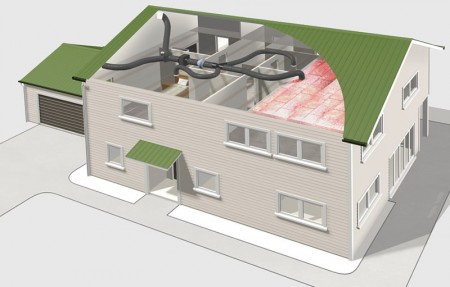 Home ventilation systems move air from the outside of your home to the inside to enhance air quality. Usually, this process involves a degree of filtration, which removes pollutants and allergens. As a result, air quality is enhanced.
Home ventilation systems move air from the outside of your home to the inside to enhance air quality. Usually, this process involves a degree of filtration, which removes pollutants and allergens. As a result, air quality is enhanced.
As well as enhancing air quality, home ventilation systems come with a host of other benefits. From maintaining a steadier temperature to eliminating dampness, they have multiple ways of making your home life more comfortable. These systems have come a long way in recent years, with some even addressing humidity. Knowing a little more about how they work can help you choose the right system for your home.
Home Ventilation Systems and Air Movement
While the air inside your home is generally quite clean, there’s never any harm in giving it a bit of a boost. Home ventilation systems respond to two different stimuli: temperature and humidity. Most systems focus on temperature only, but others—like the SmartVent Evolve—use humidity too. When the environment in your home falls outside of a certain range, the ventilation system begins to move fresh air into your home.
In most cases, this happens when you set a temperature parameter. For example, you set the system to maintain a temperature of 18 degrees. Whether it’s winter or summer, the ventilation system is going to need to kick in to reach that temperature, which means the chances of clean air moving into your home are fairly high. When this needs to happen, many systems derive air from outside your home or the roof space, before filtering it so that it’s fit to breathe.
In the case of systems that use humidity as a marker for kicking in, many will detect when condensation is about to become a problem. The SmartVent Evolve detects something called a ‘Dew’ point, which means it recognizes when humidity is reaching the stage where it could cause condensation and moves in air to dry the environment out.
The most common type of ventilation system used in New Zealand is a positive pressure system. This system forces dry air into various areas of the home, usually through vents. Balanced systems take air both from inside and outside the home, making it easier to recycle.
When using home ventilation systems like SmartVent Evolve, it is possible to control them externally using a tablet. This includes being able to set the temperature, set a schedule of temperatures, and adjusting the system so that it runs on eco and quiet modes. These systems are available to control remotely also.
What are the Benefits of Using a Home Ventilation System?
As well as making the environment cooler, a home ventilation system can make your house safer to live in. It achieves this by reducing the likelihood of damp, which in turn reduces the occurrence of mould. As mould has the potential to cause and exacerbate respiratory and skin conditions, keeping it out of your family home is essential.
The majority of home ventilation systems are easy to control and come with multiple benefits. By making the most of air outside of your home, they make ventilation economical. With one installed, it is not just possible to make your home more comfortable, you have the chance to make it an easier place to breathe in.